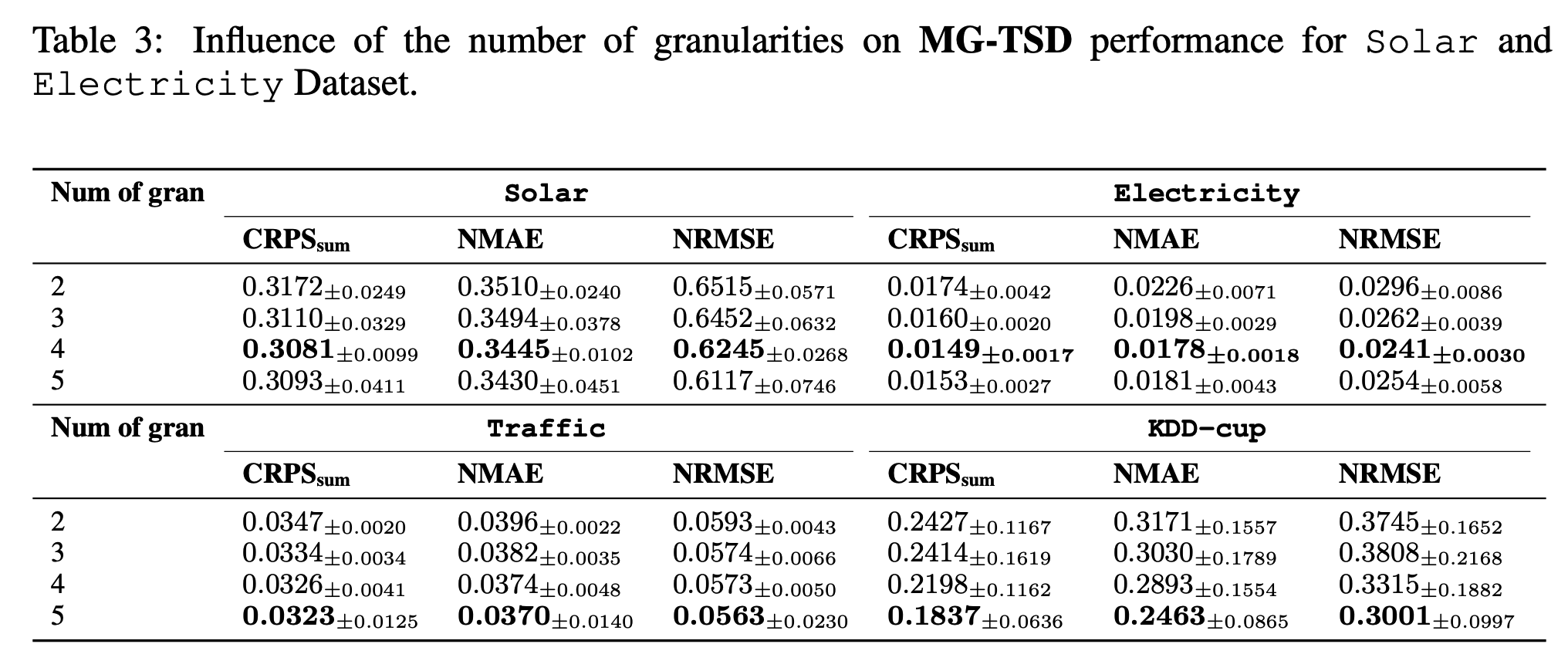MG-TSD: Multi-Granuality Time Series Diffusion Models with Guidedd Learning Process
Contents
- Abstract
- Introduction
- Background
- DDPM
- TimeGrad
- Problem Formulation
- Method
- MG-TSD Architecture
- Multi-Granularity Guided Diffusion
- Expeirments
0. Abstract
TS forecasting with diffusion
\(\rightarrow\) remains an open question
\(\because\) Challenge of instability arising from their stochastic nature
Solution: propose MG-TSD (Multi-Granularity Time Series Diffusion)
- Leverage the inherent granularity levels within data
Intuition
-
Forward process (sequentially corrupts the data)
== Process of smoothing fine-grained data into coarse-grained representation
Proposal: Multi-granularity guidance diffusion loss function
- effectively utilize coarse-grained data across various granularity levels
1. Introduction
To stabilize the output of diffusion model in TS prediction….
\(\rightarrow\) Constrain the intermediate states during the sampling process
Previous solutions
- classifier guidance
- classifer-free guidance
\(\rightarrow\) Predicted posterior mean is shifted with the gradient of either explicit or implicit classifier
Limitations: require labels as the source of guidance while sampling
( unavailable during out-of-sample inference )
2. Background
(1) DDPM
\(L_n^{\text {simple }}=\mathbb{E}_{\boldsymbol{\epsilon}, \boldsymbol{x}_0}\left[ \mid \mid \boldsymbol{\epsilon}_n-\boldsymbol{\epsilon}_\theta\left(\sqrt{\bar{\alpha}_n} \boldsymbol{x}_0+\sqrt{1-\bar{\alpha}_n} \boldsymbol{\epsilon}, n\right) \mid \mid ^2\right]\).
(2) TimeGrad
\(\mathbb{E}_{\boldsymbol{\epsilon}, \boldsymbol{x}_{0, t}, n}\left[ \mid \mid \boldsymbol{\epsilon}-\boldsymbol{\epsilon}_\theta\left(\sqrt{\bar{\alpha}_n} \boldsymbol{x}_{0, t}+\sqrt{1-\bar{\alpha}_n} \boldsymbol{\epsilon}, n, \mathbf{h}_{t-1}\right) \mid \mid ^2\right]\).
- \(\mathbf{h}_t=\mathrm{RNN}_\psi\left(\boldsymbol{x}_t, \mathbf{h}_{t-1}\right)\).
(3) Problem Formulation
Notation
- Original observed data: \(\boldsymbol{X}^{(1)}=\left[\boldsymbol{x}_1^1, \ldots, \boldsymbol{x}_t^1, \ldots, \boldsymbol{x}_T^1\right]\), where \(\boldsymbol{x}_t \in \mathbb{R}^D\).
TS prediction task
- Model the conditional distribution of future timesteps time series \(\left[\boldsymbol{x}_{t_0}^1, \ldots, \boldsymbol{x}_T^1\right]\) given the fixed window of history context.
- \(q_{\mathcal{X}}\left(\boldsymbol{x}_{t_0: T}^1 \mid\left\{\boldsymbol{x}_{1: t_0-1}^1\right\}\right)=\prod_{t=t_0}^T q_{\mathcal{X}}\left(\boldsymbol{x}_t^1 \mid\left\{\boldsymbol{x}_{1: t-1}^1\right\}\right)\).
3. Method
- Section 3.1) MG-TSD model architecture
- Section 3.2) Novel guided diffusion process module
(1) MG-TSD Architecture
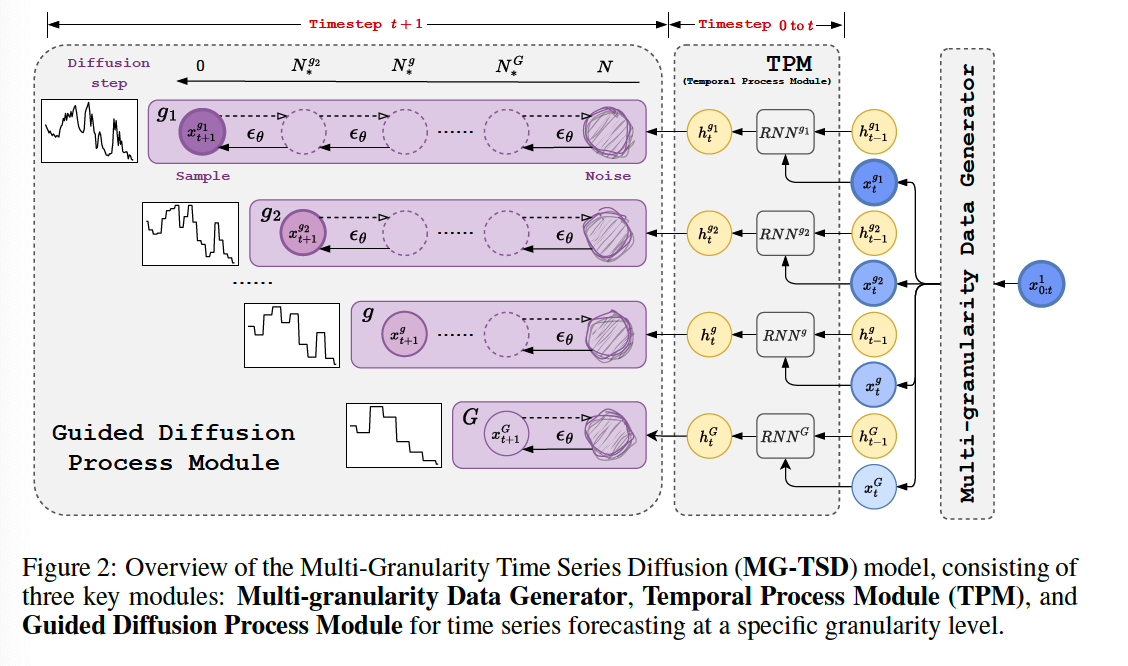
a) Multi-granularity Data Generator
-
To generate multi-granularity data from observations
-
By smoothing out the fine-grained data using historical sliding windows with different sizes
-
Notation
- \(f\) : smoothing (for example, average) function
- \(s^g\) : sliding window size (for granularity level \(g\))
- non-overlapping
\(\rightarrow\) \(\boldsymbol{X}^{(g)}=f\left(\boldsymbol{X}^{(1)}, s^g\right)\).
-
Obtained coarse-grained data for granularity \(g\) are replicated \(s^g\) times for alignment
b) Temporal Process Module
- To capture the temporal dynamics
- Utilize RNN on each granularity level \(g\) separately
- Encoded hidden states : \(\mathbf{h}_t^g\).
c) Guided Diffusion Process Module
- To generate stable TS predictions at each timestep \(t\).
- Utilize multi-granularity data as given targets to guide the diffusion learning process.
(2) Multi-Granularity Guided Diffusion
- Section 3.2.1) Derivation of heuristic guidance loss for 2 granularity case
- Section 3.2.2) Generalizez loss to multi-granularity case
a) Coarse-Grained Guidance
Notation
-
Finest-grained data \(\boldsymbol{x}_t^{g_1}\left(g_1=1\right)\) …. from \(\boldsymbol{X}^{\left(g_1\right)}\)
& Coarse-grained data \(x_t^g\) ……………. from \(\boldsymbol{X}^{(g)}\)
- Approximate the distribution \(q\left(\boldsymbol{x}^{g_1}\right)\)
- Variance schedule : \(\left\{\beta_n^1=1-\alpha_n^1 \in(0,1)\right\}_{n=1}^N\).
Suppose \(x_0^{g_1} \sim q\left(x_0^{g_1}\right)\),
- Forward trajectory \(q\left(x_{0: N}^{g_1}\right)\)
- \(\theta\)-parameterized reverse trajectory \(p_\theta\left(x_{0: N}^{g_1}\right)\).
Proposal: guide the generation of samples by ensuring that the intermediate latent space retains the underlying time series structure
\(\rightarrow\) By introducing coarse-grained targets \(\boldsymbol{x}^g\) at intermediate diffusion step \(N_*^g \in[1, N-1]\).
Objective function \(\log p_\theta\left(\boldsymbol{x}^g\right)\)
-
Evaluated at the marginal distributions at diffusion step \(N_*^g\),
( Need an appropriate choice of diffusion step \(N_*^g\), )
Marginal distribution of latent variable at denoising step \(N_*^g\)
- \(p_\theta\left(x_{N_*^g}\right)=\int p_\theta\left(x_{N_*^g: N}\right) \mathrm{d} x_{\left(N_*^g+1\right): N}=\int p\left(x_N\right) \prod_{N_*^g+1}^N p_\theta\left(x_{n-1} \mid x_n\right) \mathrm{d} x_{\left(N_*^g+1\right): N}\).
- where \(\boldsymbol{x}_N \sim \mathcal{N}(\mathbf{0}, \boldsymbol{I}), p_\theta\left(\boldsymbol{x}_{n-1} \mid \boldsymbol{x}_n\right)=\mathcal{N}\left(\boldsymbol{x}_{n-1} ; \boldsymbol{\mu}_\theta\left(\boldsymbol{x}_n, n\right), \boldsymbol{\Sigma}_\theta\left(\boldsymbol{x}_n, n\right)\right)\).
To make the objective tractable … ELBO
- achieved by specifying a latent variable sequence of length \(N-N_*^g\)
- employ a diffusion process on \(\boldsymbol{x}^g\) with a total of \(N-N_*^g\) diffusion steps
- defining a sequence of noisy samples \(x_{N_*^g+1}^g, \ldots, x_N^g\) as realizations of the latent variable sequence.
- Guidance objective:
- \(\log p_\theta\left(\boldsymbol{x}^g\right)=\log \int p_\theta\left(\boldsymbol{x}_{N_*^g}^g, \boldsymbol{x}_{N_*^g+1}^g, \ldots, \boldsymbol{x}_N^g\right) \mathrm{d} \boldsymbol{x}_{\left(N_*^g+1\right): N^*}^g\).
Simplify the loss function!
- \(\mathbb{E}_{\epsilon, \boldsymbol{x}^g, n}\left[ \mid \mid \epsilon-\epsilon_\theta\left(\boldsymbol{x}_n^g, n\right) \mid \mid ^2\right]\).
- \(\boldsymbol{x}_n^g=\left(\prod_{i=N_*^g}^n \alpha_i^1\right) x^g+\sqrt{1-\prod_{i=N_*^g}^n \alpha_i^1} \epsilon\) and \(\epsilon \sim \mathcal{N}(\mathbf{0}, \boldsymbol{I})\).
- If variance schedule : \(\left\{\alpha_n^1\right\}_{n=N^g}^N\),
- Same as \(\log p_\theta\left(\boldsymbol{x}^g\right)=\log \int p_\theta\left(\boldsymbol{x}_{N_*^g}^g, \boldsymbol{x}_{N_*^g+1}^g, \ldots, \boldsymbol{x}_N^g\right) \mathrm{d} \boldsymbol{x}_{\left(N_*^g+1\right): N^*}^g\)
b) Multi-Granularity Guidance
Data of different granularities : \(\boldsymbol{X}^{(1)}, \boldsymbol{X}^{(2)}, \ldots, \boldsymbol{X}^{(G)}\).
-
guide the learning process of the diffusion model at different steps
( = serve as constraints along the sampling trajectory )
Share ratio: shared percentage of variance schedule between
- (1) the \(g\) th granularity data, where \(g \in\{2, \ldots, G\}\)
- (2) the finest-grained data
\(\rightarrow\) Define it as \(r_g:=1-\left(N_*^g-1\right) / N\).
- ex) For the finest-grained data, \(N_*^1=1\) and \(r^1=1\).
Variance schedule for granularity \(g\)
\(\alpha_n^g\left(N_*^g\right)= \begin{cases}1 & \text { if } n=1, \ldots, N_*^g \\ \alpha_n^1 & \text { if } n=N_*^g+1, \ldots, N\end{cases}\).
and \(\left\{\beta_n^g\right\}_{n=1}^N=\left\{1-\alpha_n^g\right\}_{n=1}^N\).
- \(a_n^g\left(N_*^g\right)=\prod_{k=1}^n \alpha_k^g\),
- \(b_n^g\left(N_*^g\right)=1-\) \(a_n^g\left(N_*^g\right)\).
\(N_*^1<N_*^2 \ldots<N_*^g<\ldots<N_*^G\),
- which represents the diffusion index for starting sharing the variance schedule
Conditional inputs for the model to generate TS at corresponding granularity levels
Guidance loss function \(L^{(g)}(\theta)\)
-
for \(g\) th-granularity \(\boldsymbol{x}_{n, t}^g\) at timestep \(t\) and diffusion step \(n\),
-
\(L^{(g)}(\theta)=\mathbb{E}_{\boldsymbol{\epsilon}, \boldsymbol{x}_{0, t}^g, n} \mid \mid \left(\boldsymbol{\epsilon}-\boldsymbol{\epsilon}_\theta\left(\sqrt{a_n^g} \boldsymbol{x}_{0, t}^g+\sqrt{b_n^g} \boldsymbol{\epsilon}, n, \mathbf{h}_{t-1}^g\right) \mid \mid _2^2\right.\).
- where \(\mathbf{h}_t^g=\operatorname{RNN}_\theta\left(\boldsymbol{x}_t^g, \mathbf{h}_{t-1}^g\right)\)
Total Guidance loss function
( with \(G-1\) granularity levels of data )
- \(L^{\text {guidance }}=\sum_{g=2}^G \omega^g L^{(g)}(\theta)\),
- where \(\omega^g \in[0,1]\) is a hyper-parameter controlling the scale of guidance from granularity \(g\).
Training
\(L^{\text {final }}=\omega^1 L^{(1)}(\theta)+L^{\text {guidance }}(\theta)=\sum_{g=1}^G \omega^g \mathbb{E}_{\boldsymbol{\epsilon}, \boldsymbol{x}_{0, t}^g, n}\left[ \mid \mid \boldsymbol{\epsilon}-\boldsymbol{\epsilon}_\theta\left(\boldsymbol{x}_{n, t}^g, n, \mathbf{h}_{t-1}^g\right) \mid \mid ^2\right]\).
- denoising network parameters are shared across all granularities
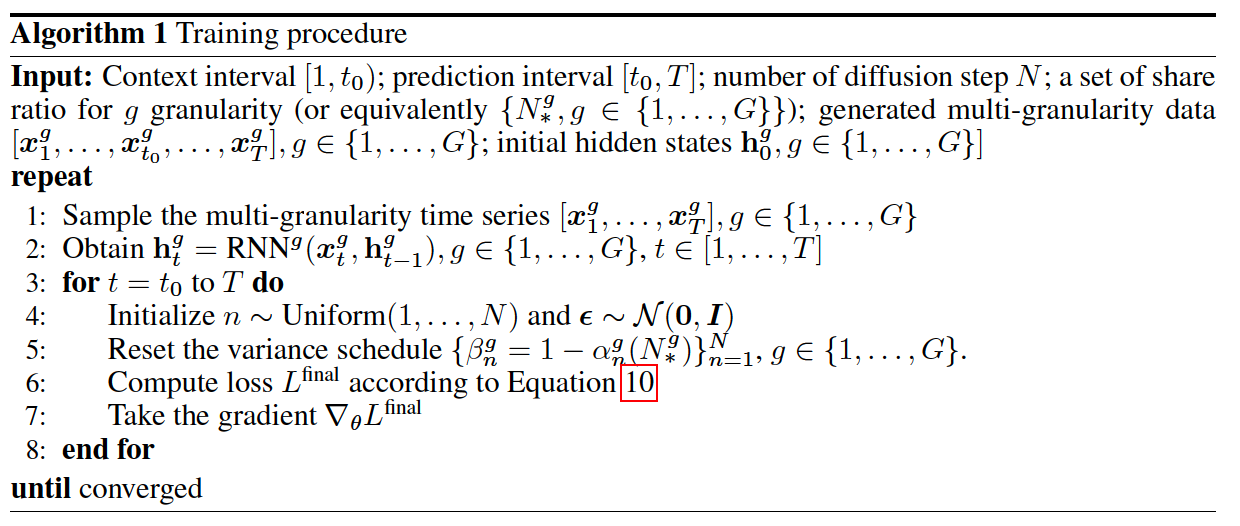
Inference
Goal: make predictions on the finest-grained data
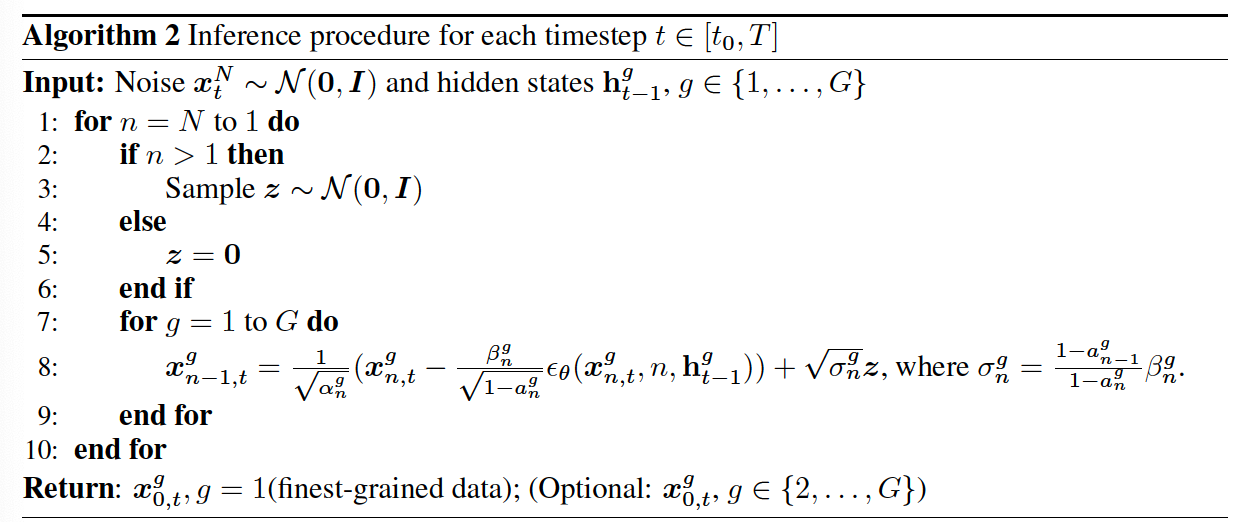
Selection of share ratio
( heuristic approach )
\(N_*^g:=\arg \min _n \mathcal{D}\left(q\left(\boldsymbol{x}^g\right), p_\theta\left(\boldsymbol{x}_n^{g_1}\right)\right)\).
- i.e. \(\mathcal{D}\) : KL Divergence
4. Experiments
(1) Settings
a) Datasets
6 Real-world datasets
- Characterized by a range of temporal dynamics
- Solar, Electricity, Traffic, Taxi, KDD-cup, Wikipedia
- Recorded at intervals of 30 minutes, 1 hour, or 1 day frequencies.

b) Evaluation Metrics
- CRPS (Continuous Ranked Probability Score)
- NMAE (Normalized Mean Absolute Error)
- NRMSE (Normalized Root Mean Squared Error)
c) Baselines
- Vec-LSTM-ind-scaling (Salinas et al., 2019)
- GP-scaling (Salinas et al., 2019)
- GP-Copula (Salinas et al., 2019)
- Transformer-MAF (Rasul et al., 2020)
- LSTM-MAF (Rasul et al., 2020)
- TimeGrad (Rasul et al., 2021)
- TACTiS (Drouin et al., 2022)
- MG-Input ensemble model
- Baseline with multi-granularity inputs
- Combines two TimeGrad models trained on one coarse-grained and finest-grained data respectively, and generates the final predictions by a weighted average of their outputs.
d) Implementation details
Hyperparameters
- 30 epochs using the Adam optimizer
- Fixed learning rate of \(10^{-5}\).
- Batch size to 128 for solar and 32 for other datasets
- Diffusion steps = 100
Additional hyperparameters
- share ratios
- granularity levels
- loss weights
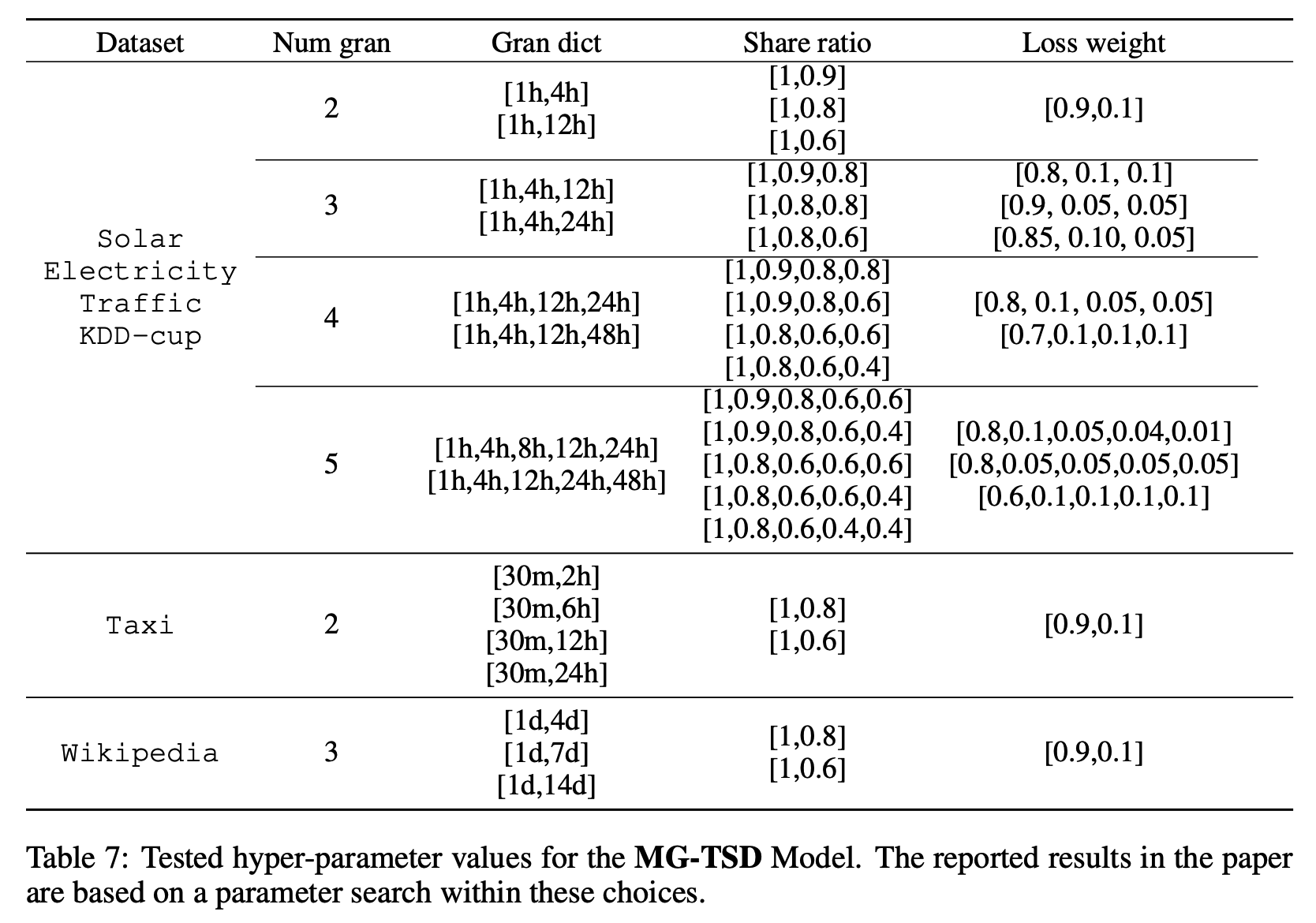
(2) Results
MG-Input model
-
Marginal improvement on certain datasets when compared to the TimeGrad
\(\rightarrow\) Integrating multi-granularity information may result in some information gain, but direct ensembling of coarse-grained outputs is inefficient!!

(3) Ablation Study
a) Share ratio of variance schedule
Various share ratios across different coarse granularities.
Two-granularity setting
-
(1) Utilized to guide the learning process for the finest-grained data
-
[Table 2]
- For each coarse granularity level, the CRPS \(_{\text {sum }}\) values initially decrease to their lowest values and then ascend again as the share ratio gets larger
- For coarser granularities, the model performs better with a smaller share ratio.
\(\rightarrow\) Suggests that the model achieves optimal performance when the share ratio is chosen at the step where the coarse-grained samples most closely resemble intermediate states
-

In practice, the selection of share ratio can follow the heuristic rule (Section 3.2.2)

-
Strong correlation exists between the polyline of CRPS sum time and the share ratio selection curve
-
As granularity transitions from fine to coarse \((4 h \rightarrow 6 h \rightarrow 12 h \rightarrow 24 h)\)…
the diffusion steps at which the distribution most resembles the coarse-grained targets increase (approximately at steps \(20 \rightarrow 40 \rightarrow 60 \rightarrow 80)\).
b) Number of granularity
